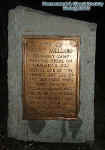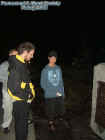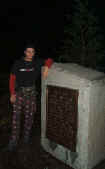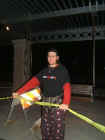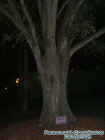|
|
||
|
At one time roughly 2,000 B.C. The Timucuan Indian tribes thrived off the shores of Lake Monroe long before Fort Mellon was even establish. They hunted, fished, drank the water and canoed along the shore burying their deceased in mounds called Middens. So keep in mind the area where we investigated is very old if not ancient in some aspects so not all ghost along the lake are from Fort Mellon some are from the Indian tribes. Lake Monroe was called the "Valdez" during Florida's occupation by Spain. When the U.S. took control it was named after president James Monroe. The St. Johns River is called the "Nile Of America" because it is one of the few rivers that flows northwards and enters in the east only to exit in the west. So this is a perfect place for wharfs, ferry's, trading. forts and fresh supplies. Fort Mellon and Mellonville came to be when in 1836 the U.S. Army established a Camp along Lake Monroe as a staging area to connect the camp to the river. The camp was enclosed by pickets on three sides but open to the river. Over 300 men were based at the camp around this time during the second Seminole War. They called the camp other names like Camp Monroe or Camp Fanning after the first commander. The army camp was near the site of a trading post which was later turned into a fort to protect early settlers from the Indians. A long pier was built in 1837 at the end of the Army road for receiving supplies. This became the Mellonville pier. Over time the river port developed as a fort disappeared. Mellonville became the end of the line for all settlers heading to south Florida when steamboat service was established between Mellonville and Jacksonville. The pier pylons still remain today you can even see that in our photos from our investigation. Lake Monroe is one of the largest lakes in Florida some say it also has some of the biggest gators here. On February 8, 1837 a force of 400 Seminoles led by Emathla (King Phillip and his son Coachoochee attacked the camp resulting in the "Battle Of Camp Monroe" If you recall King Phillip and his son were responsible for burning down various sugar mills in central Florida like for example Bulowville. The battle lasted for about three hours but ended when a Navy steamer fired a grape shot canister which prevented the Indians from victory but their were many deaths. During this battle Captain Charles Mellon was shot dead and fourteen men at the camp were wounded. Three days later the camp was renamed Fort Mellon in memory of those that had fallen by commander Fanning. In March of 1837 a Capitulation Agreement was established between the U.S. Army and the Seminole tribe. By May of that year 2,500 Seminoles including Osceola, peacefully camped near Fort Mellon under these terms of the agreement. Unfortunately the hostilities did not end which in turn the birth of Fort Reid came into play south of Fort Mellon in 1840. Many diseases before and after caused evacuations along the St. Johns River. Dr. Motte was to go and cure the soldiers at the fort then dismantle it and return to St. Augustine. In 1937 the Seminoles were weekend and of course the fort was abandoned until army commanders retook the fort with a troop movement along the shore of Lake Monroe. They did this to re-establish the fort and take it back to regain strength over the Seminoles. Back during this time period if you remember many plantations remained abandoned cause even though the Seminoles were weakened they were desperate and raiding such places including forts. The Armed Occupation Bill of 1842 encouraged settlers to come to the area by offering them 160 acres of land to anyone who built a house and stayed for five years. Most settlers came from Georgia, Virginia, and the Carolinas. In 1851the town of Mellonville had grown up around Fort Mellon while the community to the south took the name Fort Reid. In 1845 Mellonville became the county seat of the new created Orange County. It retained the position until 1856 when the seat was moved to Orlando. Mellonville was the center of commercial activity for the area. Travel guides noted the town for its orange groves and favorable location. By 1870 Mellonville was a prosperous town with many different residences and commercial districts. The town had control of the St. Johns River traffic and lake Monroe's southern shore. Henry Sanford arrived he saw potential to the area and built his city just south of Mellonville. In 1875 Mellonville was incorporated and they had separate governments till 1883 when Reid was never incorporated. With Sanford booming and consuming the area Mellonville was lost when World War II occurred. Now all that remains of Mellonville is benches, railings along Lake Monroe's southern shore, a jogging path, park, wood pylons and a few other historical buildings in the area like the New Tribes Mission. Much of the area we investigated was wide ranged as we walked through a fruit grove, park, along Lake Monroe, and passing some buildings along the way. If you want to get in a deeper history over 1000 years ago the Timucua established villages in this area where they fished, hunted and grew crops such as Maize, Squash and Beans. In the 1700s the Timucuan Indians began to die off as war and disease brought by the English, French and Spanish Colonist caused the disappearance of many. Many of the Timucuan Indians were forced to follow the European culture and religion. The Timucuan's were a peaceful tribe not warlike however in 1763 the last of them were taken to Cuba by the Spanish. Evidence of the Timucuan way of life can be found in mounds of bones, shells, tools and pottery called middens. Many of the mounds are found throughout central Florida and I believe some near Lake Monroe. After the disappearance of the Timucuan tribes the Seminoles took over the areas as they migrated from Georgia and Alabama. The term Seminole means free people! The Seminoles roamed these exact grounds. Many Seminoles left the area in the early 1800s when the U.S. government passed the Indian Removal Act which was to expand available land for the non-native settlers. Because of this clashes broke out between the Seminoles since they did not want to leave their land and wars took place between the Army and them. Osceola one of the greatest Seminole leaders once walked along Lake Monroe's shore and now we are able to bring you this story. After the Seminole war that took place near Fort Mellon many took refuge in the Everglades in southern Florida. Fort Mellon was also the site of the Doyle Wharf which was built in 1837 which had the Doyle & Brantley store. It was one of the only stores all the way to the mid 1880s. Then in 1872 the Masonic lodge began here on the second floor of the store. Their were docks, piers, and wharfs just a little west from here on Lake Monroe. Their are even some remnants remaining today if you were to walk along the shore. African Americans were first brought to the Sanford area by slave-holding families settling in Fort Mellon during the 1840s before the civil war. When Henry Sanford created his city in 1870 he used black laborers in his citrus groves. Because of this their was alot of violence from the locals so he created an African American neighborhood called Georgetown on the east side of the city. Oh and believe me not much has changed since then today the area is full of crime, drugs, and not so nice people but it still exist not to far away from where Fort Mellon once stood. Where the hotel, church, 600' pier and citrus groves are is a place called Heart Park which was dedicated in 1973 from the Central Florida Heart Association. However how the park ties into fort Mellon is that Sanford was the US minister to Belgium during Abraham Lincolns presidency. He came to Mellonville to fish and hunt in 1870 and wanted to stay. The heart park which was part of Mellonville just adjacent to where the fort once stood became the grounds where some groves were planted. Heart park and Fort Mellon Park border each other so really in my opinion its all the same. Finally we have a story near Fort Mellon in 1925 where locals called it The "Mayfair" a three story Mediterranean Revival Hotel named Forrest Lake was built. The mayor Sanford commissioned its construction for a half of million dollars. It had 158s rooms and was part of a waterfront beautification plan near Lake Monroe. In 1928 due to a investment scandal the hotel closed due to Mayor Lake and a local bank. In 1930 the hotel was purchased by the City of Sanford and was renamed the Mayfair hotel and then years later it changed hands quite a few times. It was even owned by the Kirchoff family and even the US Navy. In 1948 the hotel was purchased by the New York Giants baseball team and the name changed to The Mayfair Inn. The Giants Farm teams held spring training in Sanford during the late 1940s and early 1950's. Then in 1963 to about 1977 the hotel served as the Sanford Naval Academy which was a private military school for boys. The interior of the building was altered and all of the historical furniture was sold. Then in 1978 the New Tribes Mission a non-denominational international missionary group purchased the hotel and converted it to its organization headquarters. Many of the hotel's guest rooms were converted into apartments for the missionaries. Today the New Tribes Mission still stands and is one of the most haunted locations in Central Florida. Although we did not investigate it we did walk through the grove near by it and investigated the general area. The wood pylons which served as the hotels pier still exist today just a couple hundred feet from where Fort Mellon once stood. Also near Fort Mellon is the Sanford Museum, Heart Park and Henry Shelton's Botanical Gardens and Grove all which we briefly investigated. In my opinion the whole area has alot of energy. I mean battles, massacres, life and even death took place here. I mean the history dates back over 1000 years ago from when the Indians roamed these shores to when Sanford became a thriving city and in a way a suburb to Orlando. The area is very old and historic just a few blocks from downtown. When you get near where the fort once stood you can feel an actual difference in temperature and level in activity. You can feel that something significant happened here. But what is more intriguing is the historical sites so near one another surrounding Fort Mellon. The lake at night you can just see the fog rolling off of it as you stare off into the darkness only to see a few small towns dimly lit on the other side. I guess you can say their is sort of a gloomy feeling as very few people are out at night it is only a given that the dead roam this park which hides the true nature of what this once was. © By AngelOfThyNight-Rick
|
||
|
|
|






